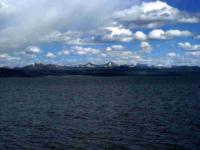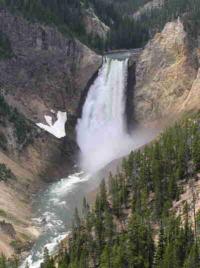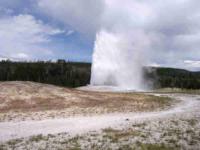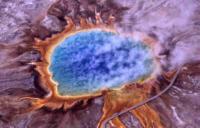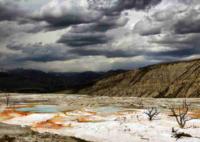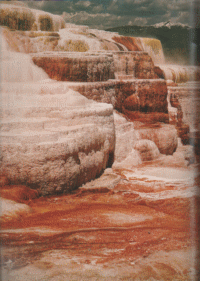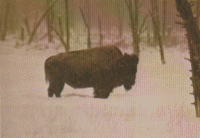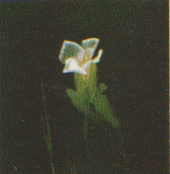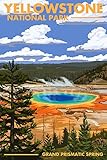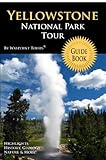 SKC Films Library |
| SKC Films Library >> American History >> United States: Local History and Description >> The West >> Rocky Mountains |
| Yellowstone National Park Located in the northwestern corner of Wyoming (with portions in southwestern Montana and eastern Idaho as well), Yellowstone is the oldest national park in the world. It also has more geysers and hot springs than any other area in the world. The park covers 2,219,823 acres. Geological Wonders A major volcanic eruption occurred in the Yellowstone area about two million years ago. About 600,000 years ago, another explosion of magma and gas created a huge crater about 40 miles long and 30 miles wide, and that crater is now occupied by Yellowstone Lake. The lake, which lies 7,733 feet above sea level, is the largest high-altitude lake in North America. It measures about 20 miles long and 14 miles wide. During the eruption, lava covered more than 1,000 square miles and formed the broad pateaus that characterize Yellowstone today. The Grand Canyon of the Yellowstone cuts through the landscape for about 20 miles. Carved by the Yellowstone River, which flows out of Yellowstone Lake, the canyon reaches a depth of about 2,000 feet in some places. The river flows over two waterfalls -- the Lower Falls plunges 308 feet, and the Upper Falls 109 feet. Grand Canyon of the Yellowstone Yellowstone remains one of the most volcanically active regions in the world. A huge mass of magma about two miles below the surface has erupted at least 27 times during the past two million years, and remains forever poised to erupt in a massive explosion again. That same magma provides heat for more than 200 active geysers and thousands of hot springs, the greatest concentration of these phenomena in the world. North Geyser Basin is the hottest and most active thermal area in Yellowstone. The temperature of the water in some of the springs reaches more than 200º F. Several of the geysers may erupt at the same time. Steamboat Geyser set a world record by hurling its water 400 feet into the air. The Upper Geyser Basin includes Old Faithful, the most famous geyser in the park, which erupts on an average of every 65 minutes; the actual intervals between eruptions actually vary from about 30 to 90 minutes. The geyser sends a stream of boiling water more than 100 feet in the air. Other geysers in the area include Castle, Giantess, Grand and Grotto. Morning Glory Pool, one of the most beautiful hot pools in the basin, resembles the flower for which it is named in both color and shape. Grand Prismatic Spring, in Midway Geyser Basin, is the largest hot spring in Yellowstone. Its pool, which has a deep blue center ringed with pink, measures 370 feet in diameter. Algae is what gives the edge of the pool its color. The Lower Geyser Basin includes the Fountain Paint Pots, a series of hot springs and bubbling pools of mud formed by steam and other gases that rose from holes in the ground and changed the surrounding rock into clay. Minerals in the clay give the mud various colors. Great Fountain Geyser erupts from the center of a large pool. Its bursts of water sometimes spout 200 feet above the pool. At Mammoth Hot Springs, beautiful terraces are formed by gently flowing waters. The waters deposit a form of limestone called travertine, building large terraces one above the other. Algae and bacteria give some of the terraces various colors. The terraces change continually through the years as the waters build them up. Some springs die, and the terraces become gray. The mountains of the Washburn Range rise most prominently in the northern part of Yellowstone Park. Mount Washburn is the highest point in the park, with an elevation of 10,243 feet. Specimen Ridge has some of the park's most famous petrified forests. The trees of this forest were buried by lava ash during volcanic eruptions over 60,000 years ago. Minerals from the ash seeped into the trees and turned them into stone. Obsidian Cliff is a mountain of black glass that was formed by molten lava. Lichens now cover the glass in many places. Plants and Wildlife More than 200 species of birds and over 40 kinds of other animals live in Yellowstone. Trumpeter swans, blue herons, white pelicans, bald eagles and gulls feed on fish in the park's lakes and rivers. Those fish include cutthroat trout, gayling, mountain whitefish and rainbow trout. Elk are the most common of the large animals in the park. Approximately 20,000 elk in the park in the summer, and about half of them stay through the winter. Yellowstone is also home to about 1,000 bison and 250 grizzly bears. Other large animals in the park include black bears, cougars, moose and mule deer. The most abundant tree in Yellowstone is the lodgepole pine. Forests of Douglas fir, Engelman spruce, limber pine and subalpine fir also grow in the park. During the summer, the mountain meadows display a variety of wildflowers, including the fringed gentian, Indian paintbush, monkey flower and mountain bluebell. fringed gentian History The Sheepeaters are known to have lived in the area now encompassed by Yellowstone Park. Other tribes, including the Bannock, Crow and Blackfeet crossed the area to hunt bison and elk. The United States obtained the Yellowstone region in 1803 as part of the Louisiana Purchase. John Colter, a member of the Lewis and Clark Expedition, was probably the first white person to see Yellowstone; he travelled alone on foot through the area in 1807 and 1808. Trappers who later explored the area often returned with stories of spouting geysers, hot springs and bubbling mudpots, but no one believed them. In 1870, General Henry D. Washburn, the Surveyor General of the Montana Territory, led an expedition to check out the reports of the trappers. In 1871, a government expedition led by geologist Ferdinand V. Hayden documented the unusual features of the park. On March 1, 1872, President Ulysses Grant signed a bill establishing Yellowstone Park to preserve its natural resources. Civilian superintendents administered the park for the first few years, but they were unable to stop widespread hunting and trapping there. The Army took over control of the park in 1886, and a detachment of cavalry protected the park and its wildlife until 1916, when Congress established the National Park Service. OFFICIAL WEBSITES SEE ALSO |
| SKC Films Library >> American History >> United States: Local History and Description >> The West >> Rocky Mountains This page was last updated on October 12, 2017. |
